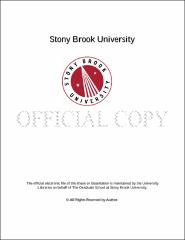| dc.identifier.uri | http://hdl.handle.net/11401/77026 | |
| dc.description.sponsorship | This work is sponsored by the Stony Brook University Graduate School in compliance with the requirements for completion of degree. | en_US |
| dc.format | Monograph | |
| dc.format.medium | Electronic Resource | en_US |
| dc.language.iso | en_US | |
| dc.publisher | The Graduate School, Stony Brook University: Stony Brook, NY. | |
| dc.type | Dissertation | |
| dcterms.abstract | Transcription factors (TF) interact with DNA to regulate gene expression by specifically binding one or two sequences out of millions of possible sites in a genome. Sequence specific binding (recognition) arises from two mechanisms: amino acid-nucleobase H-bonding (direct readout), and sequence-dependent DNA deformability and structure (indirect readout). These lead to tight, specific binding. TFs can also rapidly search for their target by attaching to any sequence and then sliding along DNA. This decreases the space through which a TF randomly walks to stumble on the target. Tight binding and rapid sliding are optimized because TFs can switch between different DNA-binding modes, a search mode and a recognition mode. Due to the disorder during search and the dynamics during recognition, the atomic level dynamics are too transient to see by experimental techniques. Therefore my goal was to develop an atomistic model of protein-DNA search and recognition using computer simulations. To meet this goal I studied a model TF, the human mitochondrial transcription termination factor-1 (MTERF1), which has a modular superhelical-architecture complementary to DNA. I used molecular dynamics (MD) simulations to characterize MTERF1 search and recognition, alongside other computational methods to generate my structural models. I was the first to observe spontaneous sliding of a TF on DNA. I found that flexibility between modules permitted contacts along the DNA footprint to shift independently. This implies that the net sliding barrier of MTERF1 is similar to the barrier for one module-DNA contact rather than the sum of all module-DNA contacts. Next I utilized enhanced sampling to drive MTERF1 over the recognition barrier(s). I found that the DNA deformed as MTERF1 made increasingly more direct readout contacts to DNA, with the global recognition process characterized by partnered DNA and MTERF1 helix unwinding. These results suggest that direct and indirect readout occur simultaneously during recognition as MTERF1 unwinds (deforms) the target DNA sequence. Helix unwinding motions were present in search mode, suggesting the dynamics that drive search and recognition are intrinsic to the MTERF1 architecture. | |
| dcterms.available | 2017-09-20T16:51:42Z | |
| dcterms.contributor | Schärer, Orlando | en_US |
| dcterms.contributor | Simmerling, Carlos | en_US |
| dcterms.contributor | Rizzo, Robert | en_US |
| dcterms.contributor | Garcia-Diaz, Miguel | en_US |
| dcterms.contributor | Coutsias, Evangelos. | en_US |
| dcterms.creator | Hauser, Kevin E. | |
| dcterms.dateAccepted | 2017-09-20T16:51:42Z | |
| dcterms.dateSubmitted | 2017-09-20T16:51:42Z | |
| dcterms.description | Department of Chemistry | en_US |
| dcterms.extent | 280 pg. | en_US |
| dcterms.format | Application/PDF | en_US |
| dcterms.format | Monograph | |
| dcterms.identifier | http://hdl.handle.net/11401/77026 | |
| dcterms.issued | 2016-12-01 | |
| dcterms.language | en_US | |
| dcterms.provenance | Made available in DSpace on 2017-09-20T16:51:42Z (GMT). No. of bitstreams: 1
Hauser_grad.sunysb_0771E_13090.pdf: 84876314 bytes, checksum: eee63cf13f4a91f1bd0857f772a6a15d (MD5)
Previous issue date: 1 | en |
| dcterms.publisher | The Graduate School, Stony Brook University: Stony Brook, NY. | |
| dcterms.subject | Chemistry | |
| dcterms.subject | DNA, Helix, Indirect readout, Protein, RNA, Sliding | |
| dcterms.title | Complementarity in the Structure and Dynamics of Protein-DNA Search and Recognition: A Multiscale Modeling Study | |
| dcterms.type | Dissertation | |

